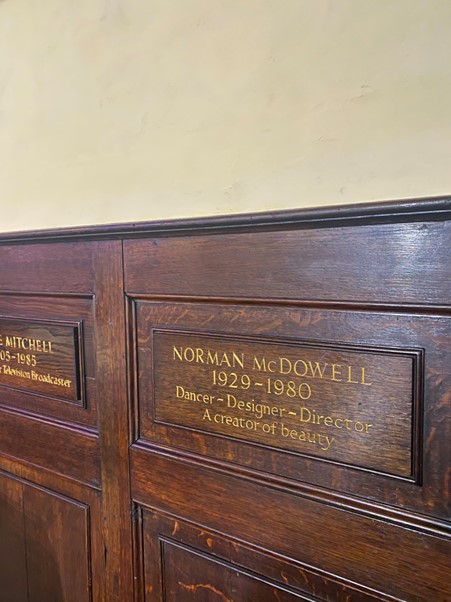Norman McDowell: The Belfast-born dancer who made his mark on British ballet
A recount of the life of Normal McDowell
Published: 19 July 2024
A recount of the life of Normal McDowell
Published: 19 July 2024

In December 1954, a Belfast man’s visit home to his parents made the local news. Under the headline ‘First Visit Home for Six Years’, the Belfast Newsletter reported that, on Christmas Eve, Norman McDowell, ‘premier dancer with the Amsterdam Ballet’, would finally ‘visit his parents’ after a long absence.[i] Although today largely forgotten, even in the world of ballet, Norman McDowell was once one of the best-known names in British modern dance.
Born in October 1929, the son of Augustus and Kathleen McDowell, young Norman’s passion for ballet was first nurtured in his home city. Although initially hoping to become an actor, Norman decided on a career in ballet after watching the company of the German choreographer Kurt Jooss perform in Belfast’s Grand Opera House in 1946. Shortly after, aged around eighteen, he joined the Belfast Ballet Club.
At the time that Norman joined, the director of the Belfast Ballet Club was Kathleen Knox, an actor and dancer who took over the Club after the death of its Ukrainian founder, Marusia Edelstyn. Norman was not the only performer of prominence to be associated with the Belfast Ballet Club: the pioneering dance teacher and Holocaust survivor Helen Lewis also provided choreography for the Club.
Norman worked with a clothing wholesaler in Belfast before leaving for London to study dance at Sadler’s Wells. Here, the young Belfast dancer crossed paths with such ballet luminaries as Lubov Tchernicheva and Anton Dolin. In 1951, Norman began performing with the Ballet Russes, a short lived revival of the original world famous company.
Around this time, Norman met Jack Carter – a fellow dancer who would become both Norman’s artistic and romantic partner. Born in Oxfordshire in 1917, Carter developed a love of Russian opera and ballet in the thirties. Before meeting Norman, Jack spent several years in the British military after being conscripted into the British forces upon the outbreak of the Second World War in 1939.
Norman and Jack’s romantic relationship, which proved shorter than their professional collaboration, was, by several accounts, tumultuous. On one occasion, while working together on a production of Japanese dances, the pair reportedly fought ‘constantly’ and managed to ‘completely destroy everything’ in their hotel bedroom.[ii]
In the early years of their relationship, Norman and Jack spent time in the Netherlands, where they worked together on their most influential collaboration: The Witch Boy. Norman played the lead role, in addition to designing the stage décor and costumes. A wonderful drawing by Norman of the Witch Boy captures his talents in art and costume design. Norman’s partner Jack handled the choreography. In the touring production, the lead role was taken over by John Gilpin, later to become a major figure in British ballet.
The Witch Boy opened Amsterdam in 1956 before touring across Europe, including Belfast, to receptions that one reporter described as verging on ‘the rapturous’.[iii] Anita Landa, who also performed in the touring production, recalled the ballet proving a particular hit in Paris, with celebrities such as Charlie Chaplin among the audience.
The success of the Witch Boy drew the attention of Noël Coward, the famous English playwright, actor and composer known for his flamboyant personality. Inspired by the Witch Boy, Coward set out to write his first and only ballet, London Morning, in collaboration with Jack Carter and Norman McDowell. Coward’s ballet wasfirst performed in 1959, with costume design by Norman and choreography by Jack.
In 1964, Norman and Anne Heaton, a dancer who had performed with the Royal Ballet, founded the London Theatre Ballet. This repertory eschewed the more famous ballets and attempted to introduce British audiences to more experimental and modern works.[iv] But the project folded after a year and Norman, along with other dancers from his company, were taken on by the London Festival Ballet. As a member of this company, Norman led the design work on an ambitious production of Sleeping Beauty.
Kim Mendez and Jinty Coventry Boyle, who worked with Norman in his final years, never recalled him speaking about Belfast. In 1977, when they toured Northern Ireland with Norman, he seemingly did not indicate that they were passing through the city where he grew up.
Norman’s London home was decorated extravagantly, with hand painted decorations and half-completed costumes adorning rooms that he shared with his Siamese cats. According to those close to him, Norman suffered with alcoholism in his final years but his early death in 1980 still came as a shock to those who knew him.[v]
A plaque unveiled in honour of Norman McDowell can be found on the southern wall of St Paul’s, Covent Garden, a church known as the ‘Actors’ Church’ due to its long association with the world of London theatre.
[i] ‘First Visit Home for Six Years’, Belfast Newsletter, 23 December 1954.
[ii] Peter Wright, Wrights and Wrongs (London, 2016), p. 316.
[iii] ‘Ballet décor by Belfastman’, Belfast Telegraph, 6 June 1958.
[iv] ‘Norman McDowell’, The Tatler, 1965.
[v] Interview with Kim Mendez and Jinty Coventry Boyle, 30 November 2022.